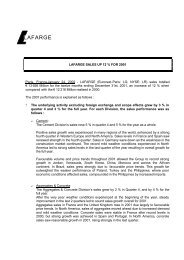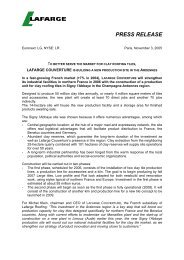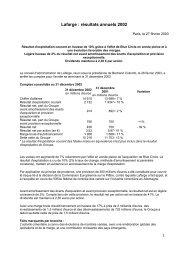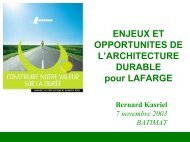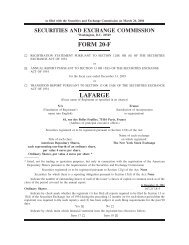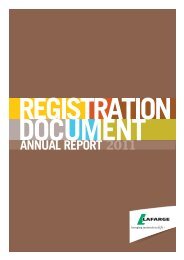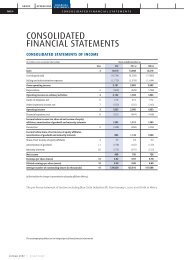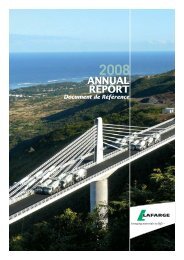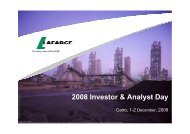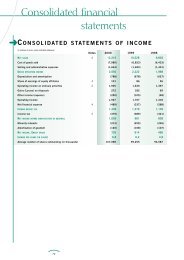Chair Ecole des Ponts Paristech - Lafarge
Chair Ecole des Ponts Paristech - Lafarge
Chair Ecole des Ponts Paristech - Lafarge
Create successful ePaper yourself
Turn your PDF publications into a flip-book with our unique Google optimized e-Paper software.
Taking you to the heart of<br />
Materials Science for<br />
Sustainable Construction<br />
<strong>Chair</strong><br />
ÉCOLE<br />
DES PONTS<br />
PARISTECH<br />
LAFARGE
“<br />
PAUL ACKER – Scientific<br />
Director, <strong>Lafarge</strong> Research<br />
Center<br />
Industrial research needs very high level<br />
scientists who are multidisciplinary and<br />
trained in the latest advances in<br />
sustainable construction. That is why<br />
<strong>Lafarge</strong> helped to <strong>des</strong>ign the master’s in<br />
Materials Science for Sustainable<br />
Construction and continues to support<br />
it today through this chair.”<br />
A unique<br />
training program<br />
The master’s in Materials Science<br />
for Sustainable Construction (SMCD)<br />
combines advanced skills in the fields<br />
of physics, mechanics and chemistry<br />
to develop an international-level training<br />
and research program focusing on<br />
sustainable development challenges.<br />
This high-level course adopts an interdisciplinary approach<br />
to the engineering of building materials. The<br />
course combines cutting-edge scientific knowledge<br />
with the acquisition of technical skills and expertise<br />
in specific industrial methodologies and tools, incorporating<br />
an in-depth analysis of current sustainable<br />
construction challenges.<br />
MATTHIEU VANDAMME – École <strong>des</strong> <strong>Ponts</strong><br />
ParisTech – <strong>Chair</strong> Coordinator<br />
“Through its support, this chair allows us<br />
to expand our civil engineering offer<br />
in training through research at the École<br />
<strong>des</strong> <strong>Ponts</strong> ParisTech. The key characteristic<br />
of this course is its interdisciplinarity,<br />
which enhances our overall offer and gives<br />
it more consistency.”<br />
The objective of this course is to develop the fundamental<br />
scientific skills required to address complex<br />
materials, incorporating environmental and energy issues<br />
linked to materials.<br />
The teaching and research team draws on the high<br />
level of teaching developed by the École <strong>des</strong> <strong>Ponts</strong><br />
ParisTech in thermodynamics, thermomechanics and<br />
micromechanics of complex continuous media. It<br />
also benefits from the industrial expertise of the <strong>Lafarge</strong><br />
Research Center, whose engineers and researchers<br />
share their knowledge and experience in<br />
the <strong>des</strong>ign and implementation of building materials.<br />
Organized around eight thematic modules corresponding<br />
to the various scientific disciplines, the master’s prepares<br />
engineers for working in R&D within cutting-edge companies<br />
and large research organizations.
Over the past few deca<strong>des</strong>,<br />
an interdisciplinary scientific<br />
approach to building materials<br />
has improved their properties,<br />
sometimes spectacularly, while<br />
reducing their environmental<br />
footprint.<br />
Building<br />
the future<br />
by 2050 the world’s population is forecast to exceed 9 billion people.<br />
This will create immense housing and infrastructure needs, which must<br />
be met whilst also protecting the environment, since climate change and<br />
the increasing scarcity of the planet’s natural resources call for a new way<br />
of <strong>des</strong>igning, producing and building. This is the major challenge facing<br />
the construction sector today. Over the past few deca<strong>des</strong>, many innovations<br />
have improved the properties of materials, sometimes spectacularly,<br />
while reducing their environmental footprint: ultra-high performance fiberreinforced<br />
concretes, self-leveling concretes, concretes with low thermal<br />
conductivity, etc.<br />
Innovating by creating materials and structures to respond to current sustainable<br />
development requirements raises numerous challenges. Innovation should make it<br />
possible to significantly reduce materials’ environmental footprint at every stage in their<br />
lifecycle, from their production to their recycling.<br />
These innovations have been made possible thanks to an interdisciplinary<br />
scientific approach, combining physicochemistry, mechanics and advanced<br />
observation and digital simulation tools. This approach allows genuine<br />
engineering of materials, which now appears to be a major lever in<br />
tackling the challenge of sustainable construction and so responding to<br />
the needs of a developing world, without compromising the future for subsequent<br />
generations.
A TRAINING PROGRAM IN WHICH INTERDISCIPLINARITY IS KEY<br />
This high-level course relies on both the fundamental knowledge of the professors<br />
at the École <strong>des</strong> <strong>Ponts</strong> ParisTech and on the applied knowledge of <strong>Lafarge</strong> engineers<br />
and researchers.<br />
, , ,<br />
SUSTAINABLE CONSTRUCTION<br />
Presentation of economic,<br />
environmental and social challenges<br />
linked to the production and use<br />
of construction materials. Analysis<br />
of materials’ lifecycle.<br />
,<br />
MIXTURE AND SEGREGATION<br />
OF FLUIDS AND GRANULAR<br />
MATERIALS<br />
Studies of the concepts and<br />
mechanisms involved in the<br />
evolution of fluid and granular<br />
materials. Mixing effect on end<br />
properties (microstructure,<br />
chemical consistency, etc.).<br />
,<br />
RHEOPHYSICS AND SOFT<br />
MATTER – COMPLEX FLUIDS<br />
Analysis of the rheophysical behavior<br />
of pastes and mixtures. Formulation<br />
methods to facilitate their application<br />
under all conditions, reducing their<br />
environmental impact and improving<br />
the quality and aesthetics of end<br />
structures.<br />
GRÉGORY CARATINI,<br />
Class of 2009,<br />
PhD student at<br />
Laboratoire Navier.<br />
PHYSICOCHEMISTRY<br />
OF BUILDING MATERIALS<br />
Study of physicochemical<br />
mechanisms of hydraulic binders<br />
and their interaction with<br />
the environment. Presentation<br />
of the main techniques for modifying<br />
these mechanisms.<br />
,<br />
MOLECULAR SIMULATION<br />
Study of the principles allowing<br />
the deduction of information from<br />
a microscopic physical system on<br />
a macroscopic scale. Digital methods<br />
for assessing a system’s average<br />
properties.<br />
,<br />
DISORDERED MEDIA<br />
AND EXPERIMENTAL<br />
PHYSICAL TOOLS<br />
Presentation of the latest results<br />
in the observation and physical<br />
characterization of the microstructure<br />
of materials.<br />
MICROMECHANICS<br />
Introduction to the techniques<br />
of changing scale applied to the<br />
modeling of the behavior of materials.<br />
,<br />
MECHANICS AND PHYSICS<br />
OF POROUS SOLIDS<br />
Analysis and laboratory<br />
experimentation involving<br />
various phenomena affecting<br />
materials: hydric transport,<br />
crystallization, thermo-hydromechanical<br />
coupling, etc.<br />
,<br />
RESEARCH INTERNSHIPS<br />
As part of the SMCD master’s, four to<br />
six months are spent on an internship<br />
in an academic or industrial research<br />
center.<br />
,<br />
A detailed <strong>des</strong>cription of the<br />
content of each of these courses<br />
can be consulted online.<br />
http://master-smcd.enpc.fr<br />
’’Followi ng civil engineering studies at the ENS<br />
in Cachan, in the second year of the master’s of science<br />
I opted for the master’s in Materials Science for Sustainable<br />
Construction. Approaching the vast field of materials<br />
science from a multidisciplinary perspective,<br />
combining chemistry, physics and mechanics,<br />
is the major strength of this course. I am convinced<br />
that future advances lie at the intersection of these<br />
different disciplines.”
THE INTERNATIONAL DIMENSION<br />
OFFERED BY THE CHAIR<br />
The <strong>Chair</strong> finances the following:<br />
TEACHING BY GUEST<br />
PROFESSORS<br />
Professors and researchers<br />
from the most prestigious<br />
universities in the world (MIT,<br />
Princeton, Berkeley, Imperial<br />
College, École Polytechnique<br />
Fédérale de Lausanne, etc.)<br />
are invited to speak as part of<br />
the SMCD master’s.<br />
INTERNATIONAL CONFERENCES<br />
Leading specialists are invited<br />
to workshops to discuss<br />
industrial issues which<br />
<strong>Lafarge</strong> researchers have<br />
translated into scientific<br />
problems.<br />
JIA WANG,<br />
Class of 2007,<br />
Engineer at the <strong>Lafarge</strong><br />
Research Center.<br />
STUDENT EXCHANGES<br />
Grants allow partner<br />
universities abroad (in China,<br />
Russia, India, etc.) to send their<br />
best students to the École <strong>des</strong><br />
<strong>Ponts</strong> ParisTech to study for the<br />
SMCD master’s.<br />
PLACEMENTS ABROAD<br />
In order to learn to work in<br />
a multicultural environment,<br />
students are offered the<br />
opportunity to carry out part<br />
of their course in a foreign<br />
country.<br />
SUPPORT FOR RESEARCH<br />
The conclusions of research<br />
projects may be published in<br />
journals with an international<br />
reach.<br />
’’<br />
CAREERS<br />
A program offering highlevel<br />
career opportunities.<br />
,<br />
SOUGHT-AFTER EXPERTISE<br />
The knowledge acquired through the<br />
SMCD master’s makes it possible to<br />
access theses and research positions<br />
in the most relevant areas of<br />
contemporary research and so, in due<br />
course, to attain positions of<br />
responsibility in fields where R&D is<br />
becoming increasingly strategic.<br />
Photos<br />
> Microstructuration test<br />
> <strong>Lafarge</strong> Research Center<br />
Image obtained using SEM –<br />
Scanning Electron Microscopy –<br />
in secondary electron mode,<br />
at various magnifications on<br />
samples of cementitious fly ash.<br />
> <strong>Lafarge</strong> Research Center: Polymers<br />
and Interfaces competency group.<br />
My engineering studies in Beijing, a dual-curriculum at the<br />
École <strong>des</strong> <strong>Ponts</strong> ParisTech and the École d’architecture<br />
de Marne-la-Vallée and an engineering course made me want<br />
to pursue research in science, but in a field related to industry.<br />
The SMCD master’s was the perfect solution. My thesis at the<br />
<strong>Lafarge</strong> Research Center was related to the hydration of a new<br />
cement enabling a reduction in CO2 emissions, and<br />
I am now working for <strong>Lafarge</strong> in China on an innovative<br />
concrete project for the city of Chongqing.”
<strong>Lafarge</strong> is the world leader in building materials and places innovation<br />
at the heart of its priorities, devoting around 150 million<br />
euros a year to <strong>des</strong>igning new products and improving industrial<br />
processes. The Group has created the world’s leading research<br />
center for building materials, which works in close collaboration<br />
with an international network of technical centers and laboratories<br />
organized by activity to develop new construction solutions.<br />
Founded in 1747, the École <strong>des</strong> <strong>Ponts</strong> ParisTech provi<strong>des</strong> master’s<br />
and doctorate degrees and continuing education for engineers<br />
with high-level scientific and general skills who go on to hold<br />
positions of responsibility in national planning and development,<br />
construction, transport, industry and the environment.<br />
The education provided is at the intersection of fundamental and<br />
applied research. The school, which is in constant contact with<br />
companies and public authorities, works with numerous international<br />
partners.<br />
ADMISSIONS<br />
École <strong>des</strong> <strong>Ponts</strong> ParisTech, 6 et 8 avenue Blaise-Pascal, Cité Descartes, Champs-sur-Marne, 77445 Marne-la-Vallée Cedex.<br />
Tel: +33 (0)1 64 15 30 00.<br />
The enrolment form is available to download from the site: http://master-smcd.enpc.fr<br />
Xavier Chateau – Director of the SMCD master’s – xavier.chateau@enpc.fr<br />
Alice Tran – Assistant to the SMCD master’s – alice.tran@enpc.fr<br />
GRANTS<br />
Thanks to support from the <strong>Chair</strong>, the École <strong>des</strong> <strong>Ponts</strong> ParisTech offers grants to SMCD master’s students.<br />
Matthieu Vandamme – <strong>Chair</strong> Coordinator – matthieu.vandamme@enpc.fr<br />
> Cover photo: <strong>Lafarge</strong> Research Center: Analyses and Measurements competency group.<br />
ÉCOLE DES PONTS<br />
PARISTECH<br />
6 et 8 avenue Blaise-PascaI<br />
Cité Descartes<br />
Champs-sur-Marne<br />
77455 Marne-la-Vallée Cedex, France<br />
www.enpc.fr<br />
LAFARGE<br />
61, rue <strong>des</strong> Belles-Feuilles,<br />
BP 40<br />
75782 Paris Cedex 16, France<br />
Tel.: +33 1 44 34 11 11<br />
Fax: +33 1 44 34 12 00<br />
www.lafarge.com




